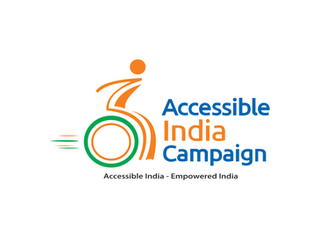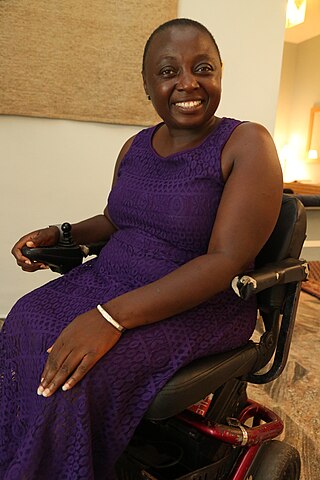
Parasports are sports played by people with a disability, including physical and intellectual disabilities. Some parasports are forms of adapted physical activities from existing able-bodied sports, while others have been specifically created for persons with a disability and do not have an able-bodied equivalent. Disability exists in four categories: physical, mental, permanent and temporary. At a competitive level, disability sport classifications are applied to allow people of varying abilities to face similar opposition.

Disability is the experience of any condition that makes it more difficult for a person to do certain activities or have equitable access within a given society. Disabilities may be cognitive, developmental, intellectual, mental, physical, sensory, or a combination of multiple factors. Disabilities can be present from birth or can be acquired during a person's lifetime. Historically, disabilities have only been recognized based on a narrow set of criteria—however, disabilities are not binary and can be present in unique characteristics depending on the individual. A disability may be readily visible, or invisible in nature.
The disability rights movement is a global social movement that seeks to secure equal opportunities and equal rights for all people with disabilities.
Special education is the practice of educating students in a way that accommodates their individual differences, disabilities, and special needs. This involves the individually planned and systematically monitored arrangement of teaching procedures, adapted equipment and materials, and accessible settings. These interventions are designed to help individuals with special needs achieve a higher level of personal self-sufficiency and success in school and in their community, which may not be available if the student were only given access to a typical classroom education.

The social model of disability identifies systemic barriers, derogatory attitudes, and social exclusion, which make it difficult or impossible for disabled people to attain their valued functionings. The social model of disability diverges from the dominant medical model of disability, which is a functional analysis of the body as a machine to be fixed in order to conform with normative values. While physical, sensory, intellectual, or psychological variations may result in individual functional differences, these do not necessarily have to lead to disability unless society fails to take account of and include people intentionally with respect to their individual needs. The origin of the approach can be traced to the 1960s, and the specific term emerged from the United Kingdom in the 1980s.

Invisible disabilities, also known as hidden disabilities or non-visible disabilities (NVDs), are disabilities that are not immediately apparent. They are typically chronic illnesses and conditions that significantly impair normal activities of daily living.

Inclusion, in relation to persons with disabilities, is defined as including individuals with disabilities in everyday activities and ensuring they have access to resources and opportunities in ways that are similar to their non-disabled peers. Disability rights advocates define true inclusion as results-oriented, rather than focused merely on encouragement. To this end, communities, businesses, and other groups and organizations are considered inclusive if people with disabilities do not face barriers to participation and have equal access to opportunities and resources.

The Convention on the Rights of Persons with Disabilities is an international human rights treaty of the United Nations intended to protect the rights and dignity of persons with disabilities. Parties to the convention are required to promote, protect, and ensure the full enjoyment of human rights by persons with disabilities and ensure that persons with disabilities enjoy full equality under the law. The Convention serves as a major catalyst in the global disability rights movement enabling a shift from viewing persons with disabilities as objects of charity, medical treatment and social protection towards viewing them as full and equal members of society, with human rights. The convention was the first U.N. human rights treaty of the twenty-first century.

The China Disabled Persons' Federation is a people's organization for individuals with disability in China established in Beijing, China in March 1988. The predecessors of the CDPF are the China Association for the Blind and Deaf, established in 1960 and the China Welfare Fund for the Handicapped established in 1984. The three basic functions of the CDPF are to represent the interests of people with disabilities in China and help protect their legitimate rights, to provide them with comprehensive and effective services and to supervise affairs relating to people with disabilities commissioned by the Chinese government. The emblem of the CDPF looks like a plum flower which features prominently in Chinese art and culture. With its motto "humanity, probity, service and contribution" the CDPF has helped many disabled persons.
Disability in China is common, and according to the United Nations, approximately 83 million people in China are estimated to have a disability.

Accessible India Campaign or Sugamya Bharat Abhiyan is a program which is set to be launched to serve the differently-able community of the country. The program comes with an index to measure the design of disabled-friendly buildings and human resource policies. The flagship program has been launched by the Prime Minister on 3 December 2015, the International Day of people with Disabilities. The initiative also in line with the Article 9 of the to which India is a signatory since 2007. The scheme also comes under Persons with Disabilities Act, 1995 under section 44, 45, 46 for equal Opportunities and protection of rights which provides non-discrimination in Transport to Persons with Disabilities.
There are 26.8 million people with disabilities in India according to the 2011 census of India, while other sources have offered higher estimates. India is a party to the United Nations Convention on the Rights of Persons with Disabilities. Legislation that affects people with disabilities in India includes the Rights of Persons with Disabilities Act, 2016, the Mental Health Care Act, 2017, the National Trust Act, 1999, and the Rehabilitation Council of India Act, 1992. People with disabilities in India are faced with negative social attitudes in the wider population.
Estimates vary for the number of people with disabilities in Nigeria, ranging from under 3 million people to over 25 million. Nigerian law prohibits discrimination against people with disabilities.

Lois Auta is the founder and chief executive officer at the Cedar Seed Foundation, an organization that promotes the participation of women with disabilities into human rights based development in Nigeria. She focuses on inclusive legislation for people with disabilities.

Disability in Yemen has been increasing over time, especially because of increased conflict in the area. Disabled people in Yemen face many challenges due to poverty, lack of accessible infrastructure, gender segregation and more. The government of Yemen has passed laws to help protect the rights of disabled people in their country, but not all laws are equally enforced.

Singapore does not have a formal definition of disability. Singapore signed on to the Convention on the Rights of Persons with Disabilities in 2013 and coordinates the Enabling Masterplan with both government and non governmental organisations.

The United Nations Framework Convention on Climate Change (UNFCCC), the Paris Agreement, the Sustainable Development Goals (SDGs), and the United Nations Convention on the Rights of Persons with Disabilities (CRPD) are connected through their common goals of addressing global challenges and promoting sustainable development through policies and international cooperation.
Disability in Kenya "results from the interaction between individuals with a health condition with personal and environmental factors including negative attitudes, inaccessible transport and public buildings, and limited social support. A person's environment has a huge effect on the experience and extent of disability." Having a disability can limit a citizen's access to basic resources, basic human rights, and social, political and economic participation in Kenyan society. There are three forms of limitation of access linked to disability: impairment, disability, and handicap. An impairment is "the loss or abnormality of psychological, physiological or anatomical structure or function." A disability results from an impairment as "the restriction or lack of ability to perform an activity in the manner considered normal for a human being", and the requirement for accommodation. Finally, a handicap "results from a disability, and limits or prevents the fulfilment of a role that is normal for that individual."

The Estonian Chamber of People with Disabilities, also translated as Estonian Chamber of Disabled People, is the largest association of people with disabilities in Estonia. The Chamber functions as a non-profit umbrella organization that represents various organizations of people with disabilities in Estonia since 1993. The objective of the activities of the Estonian Chamber of Persons with Disabilities is to improve the livelihoods, quality of life and social inclusion of people with disabilities.












